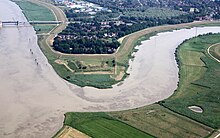Leda (river)
Appearance
| Leda | |
|---|---|
 | |
 | |
| Location | |
| Location | Lower Saxony, |
| Physical characteristics | |
| Source | |
| • location | northwest of Spahnharrenstätte |
| • coordinates | 52°53′30″N 7°34′02″E / 52.89167°N 7.56722°E |
| • elevation | 25 m above sea level (NN) as "Ohe" |
| Mouth | |
• location | southwest of Leer into the Ems |
• coordinates | 53°12′37″N 7°25′27″E / 53.21033°N 7.42414°E |
• elevation | 1 m above sea level (NN) |
| Length | 75 km (47 mi) |
| Basin size | 1,917 km2 (740 sq mi) |
| Basin features | |
| Progression | Ems → North Sea |
| River system | Ems |
| Landmarks | Villages: Breddenberg, Sedelsberg, Ramsloh, Strücklingen, Potshausen |
| Tributaries | |
| • left | Hauptfehn Canal, Polder Canal |
| • right | Loruper Beeke, Rittveengraben, Marka, Bollinger Canal, Jümme |
| Navigable | 25 km (16 mi) |
The Leda is a river in north-western Germany in the state of Lower Saxony. It is a right tributary of the Ems and originates at the confluence of the Sagter Ems and the Soeste (Dreyschloot) near the town of Barßel. The Leda flows into the Ems near the town of Leer. On the southern bank of the Leda, in the Overledingen Land (Overledingen="country over the Leda"), opposite Leer, lies the small settlement of Kloster Muhde (Muhde from the Old Frisian mutha meaning "(river) mouth"). The total length of the river is 29 kilometres (18 mi), of which the lower 1.9 kilometres (1.2 mi) are navigable for sea-going vessels.[citation needed]

In East Frisia the Sagter Ems, a headstream of the Leda, is also known as the Leda.
